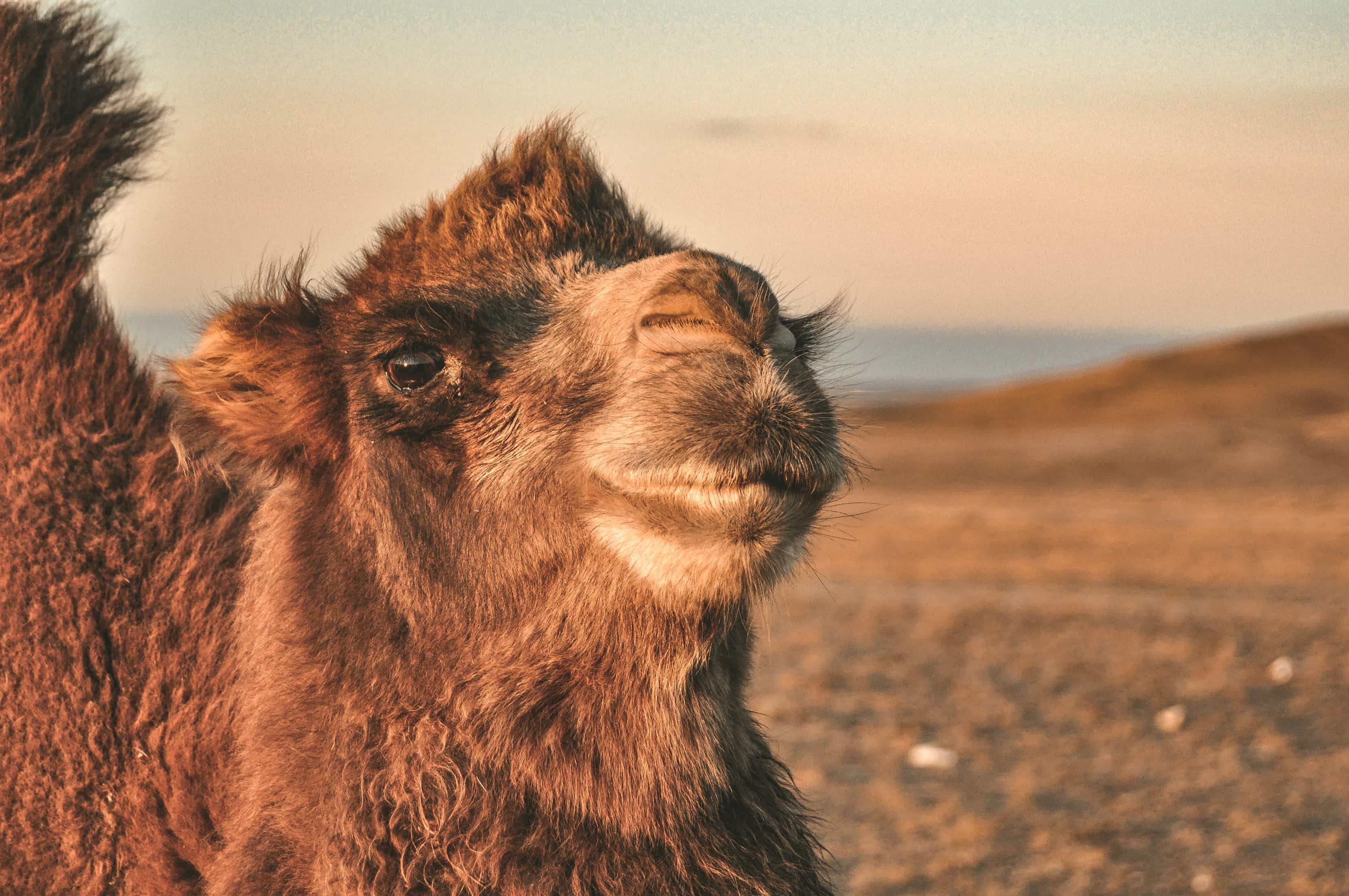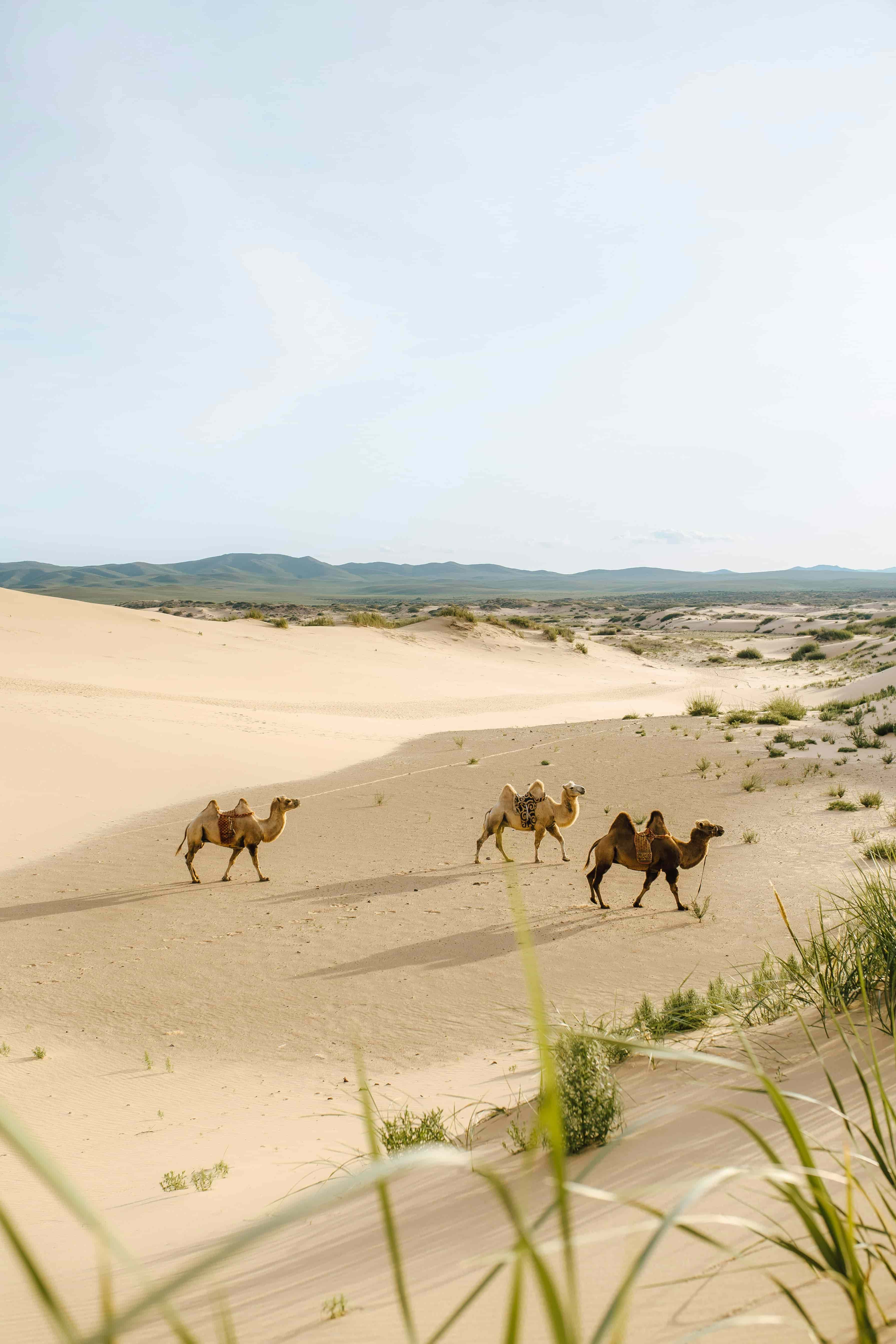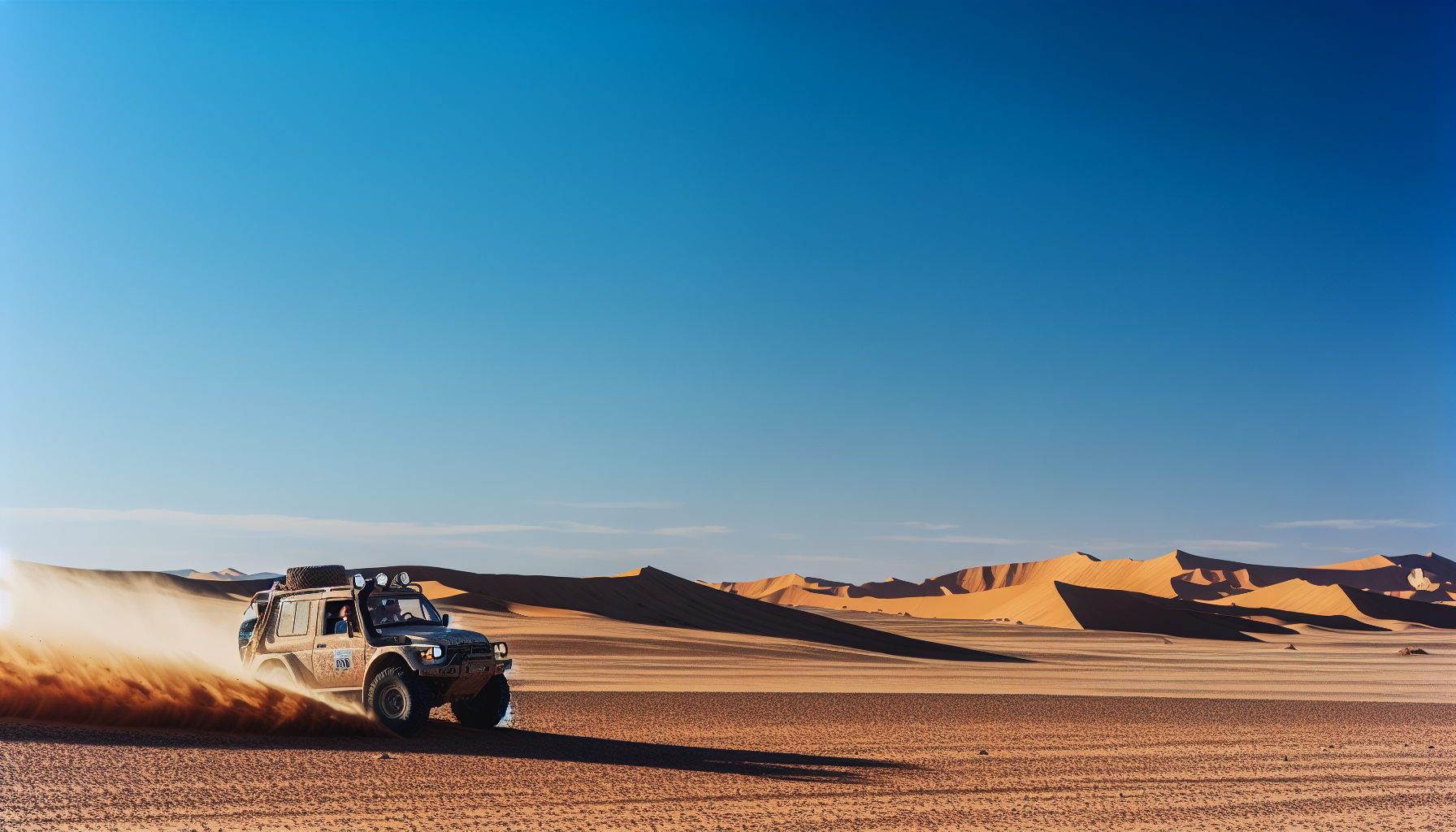Khongor Sand Dunes in the Gobi
Contact us for travel suggestions
Exploring the Majestic Khongor Sand Dune: A Jewel of the Gobi Desert
Are you intrigued by the towering Khongor Sand Dune, a signature feature of the vast Gobi Desert? This guide unveils what draws adventurers to this site—its imposing heights, the phenomenon of singing sands, and a diverse ecosystem. Delve into practical travel advice to experience the dune’s majesty firsthand, without the fluff or exaggeration, just essential insights for your expedition to one of Mongolia’s natural treasures.
Key Takeaways
- The Khongor Sand Dunes, stretching up to 800 meters high and over 180 km long, offer both aesthetic beauty and a rare acoustic phenomenon known as ‘singing sands’ caused by the movement of the sand.
- The dunes’ diverse ecosystem is home to unique wildlife, including the Saker falcon and Bactrian camels, and is a subject of conservation efforts to protect these species.
- Tourists can scale the dunes to witness stunning panoramic views and experience eco-friendly tourism while supporting local communities, with the best climbing conditions in the morning or late evening to avoid extreme heat.
Uncovering the Secrets of Khongor Sand Dune

Standing tall in the heart of Mongolia’s majestic Gobi Desert, the Khongor Sand Dunes are a sight to behold. This expansive sandy region, also known as the Khongoryn Els Sand Dunes, extends over 180 km in length and can reach up to 27 km in width, with the tallest dunes soaring up to 800 meters high. The formation of these awe-inspiring dunes is a testament to nature’s artistry. As the wind carries and deposits sand particles throughout the desert, the neighboring mountain range shapes the dunes, restraining the wind’s ability to move the sand beyond a certain point.
The small Khongoryn Gol river enhances the charm of the Khongor Sand Dune, as it borders its northern perimeter. This river nurtures lush green meadows that stand out strikingly against the desert’s sandy backdrop, adding to the dune’s intrinsic natural allure. The fascination of the Khongor Sand Dune extends beyond its visual appeal. We’ll delve into the phenomenon that imparts a musical voice to these dunes and introduce the varied wildlife that inhabits this dune.
The Singing Sands Phenomenon
Imagine standing amidst the vast expanse of the Gobi desert, surrounded by towering sand dunes, and you hear a deep, resonating hum filling the air. This is the phenomenon of singing dunes, a unique experience where the sand dunes emit a powerful sound as sand particles are carried by the wind or cascade down in small avalanches. This mesmerizing phenomenon at Khongor Sand Dune is primarily a result of avalanches cascading down the slopes of the sand dunes.
Interestingly, this enchanting symphony of the sands is not unique to the Khongor Sand Dune. This phenomenon can be experienced in numerous locations around the globe. However, the distinct sound produced at Khongor Sand Dune is influenced by various weather conditions, including the movement of sand caused by the wind and the avalanches triggered by weather patterns.
Having explored the sands’ symphony, we now turn our attention to the silent audience of this musical performance - the wildlife of the Khongor Sand Dune.
Wildlife at Khongor Sand Dune

The Khongor Sand Dune is home to a fascinating array of wildlife. Some of the remarkable creatures that can be found there include:
- The majestic Saker falcon
- Pallas’s sandgrouse
- The elusive Corsac fox
- The graceful black-tailed gazelles
These animals have evolved unique adaptations to survive in this environment. For instance, the Wild Bactrian camels have developed bodily adaptations tailored to their specific needs, while Pallas’s sandgrouse can store water in their belly feathers to withstand the harsh desert conditions.
Efforts to conserve the wildlife at Khongor Sand Dune are underway. Measures like sustainable legal harvest, habitat loss combatting, and trapping prevention are being implemented to safeguard the Saker falcons in particular.
Having discovered the marvels of the dunes and their inhabitants, we now change direction to discuss the exhilarating experience of climbing the Khongor Sand Dune.
A Hiker's Paradise: Climbing the Khongor Sand Dune

For adventure seekers, the Khongor Sand Dune presents a unique challenge - a steep climb that rewards you with a breathtaking panoramic vista. As you ascend these towering dunes, the vastness of the Gobi desert unfolds before you, offering a sight that’s truly mesmerizing. Some highlights of the Khongor Sand Dune include:
- The steep climb that challenges your physical abilities
- The panoramic vista that awaits you at the top
- The vastness of the Gobi desert that stretches out before you
- The vibrant colors of the dunes that are enhanced by the light during sunset
Experiencing the Khongor Sand Dune is an adventure you won’t want to miss.
But what is the optimal time to undertake this climb, and how can one prepare for it? Let’s discover.
Best Time to Climb
The best time to begin your ascent of the Khongor Sand Dune is during the early morning or late evening when the cool air creates a more pleasant climbing experience. Moreover, scaling the dunes for sunset or avoiding the peak tourist times can further enrich the experience.
The weather at the Khongor Sand Dune changes with the seasons. Here is some information about the weather conditions throughout the year:
- Springtime is known for strong winds, particularly in the afternoons, and temperatures can fluctuate, reaching highs in the 60s F. Therefore, it’s important to stay updated on the latest weather forecast before embarking on your climb.
- The average temperature range in July is +20°C to +40°C, with daytime temperatures peaking at 30°C.
- Towards the end of May, June, and late August, nighttime temperatures can drop to +8°C.
Considering these factors, we’ll provide some tips for a successful climb.
Tips for a Successful Climb
Ascending the Khongor Sand Dune is an exciting challenge. The journey usually takes between 30 minutes to an hour, but the loose sand can make the climb physically demanding, potentially extending the duration to as much as two hours. Proper preparation is crucial to tackling this challenge. Here are some tips to help you:
- Gradually acclimate to elevated heights
- Ensure proper hydration
- Maintain a steady pace
- Refrain from consuming alcohol
Following these tips can help your body adjust to the altitude changes and make your climb more enjoyable.
When it comes to safety precautions, safeguarding your feet with closed-toe shoes and shielding your skin with sunscreen are essential. Also, it’s advisable to avoid climbing during the peak heat in summer afternoons for safety.
Having prepared ourselves to tackle the dunes, we’ll now investigate the life-sustaining oases and rivers at the heart of the Gobi Desert.
Oasis and River: Natural Wonders of the Gobi Desert

In the heart of the Gobi Desert, the Khongoryn River weaves its way through the sand dunes, giving life to oases that stand as remarkable features amidst the vast desert terrain. These oases play a crucial role in desert ecosystems, serving as a source of water that sustains vegetation, creates habitats for wildlife, and supports human communities living in these dry regions.
Oases in the Gobi Desert are formed typically when underground water seeps to the surface or when there’s an influx of freshwater, supporting life in areas that are otherwise arid and dry. But these oases are not just lifelines in the desert; they also offer a range of recreational activities for visitors.
The Importance of the Oasis
The oasis holds great importance in desert ecosystems. Not only does it serve as a crucial source of water, but it also enhances biodiversity by serving as a sanctuary for various forms of life. The oases nurture a diverse range of species that have adapted to the challenging desert and semi-desert environments, thereby contributing to the overall biodiversity of the region.
The oasis is teeming with:
- Saxaul trees
- Camel thorn bushes
- Resilient grasses
- A diverse range of wildlife including wild Bactrian camels, Gobi bears, and various bird species, including the elusive snow leopard
Local communities rely on the oasis for farming and agriculture, utilizing a network of aqueducts and underground falajes to distribute water to their crops.
Moving on from this life-sustaining oasis, we’ll now delve into the thrilling activities available for visitors near the ancient sea.
Activities at the Oasis
The oasis, with its rich biodiversity, offers an exciting array of recreational activities. Birdwatching and wildlife spotting allow visitors to observe the diverse species that inhabit this region. From the Pallas sand grouse and goitred gazelles to the Mongolian gazelles, visitors can come face to face with the vibrant life that thrives in this desert oasis.
Birdwatchers, in particular, can often catch sight of species like the Ruddy Shelduck, Mallard, Spot-billed Duck, Little Ringed Plover, and Northern Lapwing as they enjoy the waters of the oasis near a small river.
Having discovered the natural wonders of the Mongolian Gobi Desert, including the Gobi Sand Dunes, we can now start planning the trip to the Khongor Sand Dunes.
Planning Your Trip to Khongor Sand Dune
Planning your trip to the Khongor Sand Dune involves more than just packing your bags. It’s about choosing the right route, tour options and accommodations to ensure a memorable experience. AVIS Travel offers a diverse range of tour options, from one week quick escapes to the Gobi desert, two weeks round trip to the Gobi and Central Mongolia and three weeks driving along Mongolia's Ring Road to the Altai mountains in Western Mongolia and back across the Gobi desert. AVIS Travel has got you covered, ensuring a diverse selection for exploring Khongor Sand Dune.
AVIS Travel is renowned for its meticulously crafted itineraries and exceptional service, providing 24/7 support to ensure a seamless travel experience while exploring the Khongor Sand Dune. Before embarking on the journey, let’s discuss the accommodation options during the trip.
Tour Options from Ulaanbaatar
AVIS offers trips to the Khongor Sand Dune from Ulaanbaatar. The itineraries typically encompass a wide range of activities that offer a comprehensive experience of the Khongor Sand Dune. These may include visiting Yol Gorge and Bayanzag the Flaming Cliffs. Additionally, tourists can look forward to climbing the Singing Sand, hiking in Yolyn Am valley, trekking in Eagle Valley, visiting nomads, enjoying camel rides, and exploring ancient rock drawings.
The typical cost for tours from Ulaanbaatar to Khongor Sand Dune is approximately US$ 1.500 per person for a group of 3, and US$ 1.300 per person for a group of 4. However, the prices can differ based on the number of individuals and the specific tour package selected. Past travelers have expressed great satisfaction with AVIS Tours, particularly enjoying the camel ride and the stunning scenery during their experience.
Next, we’ll delve into the available accommodation options.
Staying at the Khongoryn Els Ger Camp
During your visit to the Khongor Sand Dunes, you’ll have the opportunity to stay at one of several Ger Camps close to Khongoryn Els. These camps offers a traditional Mongolian setting with accommodations in gers and charming log cabins. Most camps also features communal shower and toilet blocks to ensure the convenience of its guests.
Packing Essentials for Your Khongor Sand Dune Adventure
Packing for your adventure to the Khongor Sand Dune involves more than just tossing clothes into a suitcase. It’s about carefully selecting items that will ensure your comfort and safety during your journey. Consider including:
- Lightweight and breathable clothing like t-shirts, a jacket, fleece, rain jacket, and outdoor trousers
- Long-sleeve shirts and pants for added sun protection
- Warm clothing for cooler evenings
When it comes to footwear, you have the option to go barefoot for a more immersive experience with the sand. However, if you prefer wearing shoes, it is advisable to opt for robust, snug, and enclosed footwear rather than flip-flops or open-toe shoes. Additionally, it is recommended to bring along a hat and sunglasses for extra protection.
Beyond clothes and footwear, we’ll discuss the essential gear and personal items required for the trip.
Clothing and Footwear
When it comes to desert attire, here are some tips to keep in mind:
- Wear breathable natural fabrics such as cotton and linen to help maintain a cool temperature.
- Opt for closed-toe shoes to provide protection for your feet against the rugged terrain.
- Don long sleeve shirts and long pants to shield yourself from the harsh desert conditions.
- Wrap a desert scarf around your head and neck for added protection.
- Choose white or bright clothing that reflects UV rays rather than absorbing them.
Following these tips will help you stay comfortable and protected in the desert.
The most suitable footwear for navigating Khongor Sand Dunes includes shoes specifically designed for sandy terrain, such as the Lowa Tibet LL Trekking Boot, Adidas Terrex AX3, and Watelves Sport.5 Sand Shoe. Now, let’s move on to the gear and personal items that you should pack.
Gear and Personal Items
In preparation for climbing the Khongor Sand Dune, it is essential to pack:
- Comfortable shorts and a shirt
- Water to stay hydrated
- One electronic device for communication or photography, preferably stored in a sealed bag to shield it from sand.
To enhance your comfort during your journey to Khongor Sand Dune, consider bringing a backpackers bag, a book or downloaded TV/Movies, a headlamp, biodegradable soap, hiking boots, a waterproof jacket or other rain gear, a broad-brimmed hat, proper footwear, and layers that include a fleece jacket and an outer shell jacket. In the expansive and challenging terrain of the Gobi Desert, tourists can engage in waste management by utilizing biodegradable litter bags, directing waste away from landfills, and adhering to environmentally conscious practices established by tour operators.
Now that we are prepared for our adventure, we can concentrate on how to contribute to the preservation of the Gobi Desert’s beauty.
Preserving the Beauty of the Gobi Desert: Responsible Tourism Practices
Responsible tourism is not just about enjoying the beauty of a destination; it’s also about preserving that beauty for future generations. When visiting desert areas like the Khongor Sand Dune, it’s important to minimize our impact by leaving no trace. This includes packing out all waste and avoiding disturbing wildlife. Additionally, responsible tourism entails supporting local communities and showing respect for their customs and traditions.
Tourists can play a part in preserving the natural allure of the Gobi Desert by engaging in guided tours provided by national parks such as Gobi Gurvansaikhan and Hustai National Park, both of which are deeply dedicated to the protection of wildlife. Furthermore, immersing in the renowned hospitality of nomads and residing with nomadic families can also contribute to the maintenance of the desert’s allure. It is crucial for tourists to prioritize responsible and sustainable practices, as sustainable tourism plays a key role in the conservation of natural areas and wildlife.
Having addressed responsible tourism, we’ll now explain how to reach the Khongor Sand Dunes.
How to get to Khongor Sand Dunes

Reaching the majestic Khongor Sand Dune is an adventure in itself. The vast expanse of Khongor Sand Dunes lies more than 180 km away from Ulaanbaatar, and the journey by car is estimated to take around 8 hours. The path leading to Khongor Sand Dunes is a rugged, unpaved dirt road that bears the marks of frequent vehicle passage.
Several noteworthy landmarks, such as the Flaming Cliffs and the sand dunes themselves, punctuate the journey from Ulaanbaatar to Khongor Sand Dunes. But what’s the best way to navigate this journey? Let’s discover.
How to drive to Khongor Sand Dunes from Ulaanbaatar?
Embarking on the journey from Ulaanbaatar to Khongor Sand Dunes will lead you through diverse landscapes, culminating in a challenging off-road segment. 4X4 vehicles are recommended for navigating the rough terrain and bumpy sections along the way. The journey from Ulaanbaatar to Khongor Sand Dunes typically takes around 4 hours, provided that the travel is conducted in a well-equipped vehicle like a 4X4.
On the route to Khongor Sand Dunes from Ulaanbaatar, travelers should prepare for:
- notably uneven and rough road conditions
- especially during the off-road portion towards the conclusion of the trip
- especially if traveling in a 4X4 vehicle.
Next, we’ll investigate the route from Dalanzadgad to Khongor Sand Dunes.
How to drive to Khongor Sand Dunes from Dalanzadgad?
The distance from Dalanzadgad to Khongor Sand Dunes spans approximately 180 kilometers (110 miles). The suggested driving route covers about 200 kilometers and typically takes around 2-3 hours to complete. The road leading to Khongor Sand Dunes is a rugged dirt road, and it is advisable to utilize 4X4 vehicles, especially for the final stretch of the drive, to navigate the challenging terrain.
As you embark on this journey, you will traverse through a pass nestled in the Altai Mountains and be treated to the breathtaking sight of the expansive Khongor Sand Dunes stretching out before you. Although there are no designated service stations along the route, a rewarding stop can be made at the Khongor Sand Dunes in the Gobi Gurvansaikhan National Park for exploration.
Having reached our destination, it’s time to draw some conclusions.
Summary
From the singing sands to the thriving wildlife, the Khongor Sand Dune in the heart of the Gobi Desert is indeed a unique destination. Whether you’re an adventure seeker looking to conquer the dunes or a nature lover yearning to explore the rich biodiversity, Khongor Sand Dune has something for everyone. As we partake in these extraordinary experiences, let’s remember our responsibility to preserve the natural allure of the Gobi Desert for future generations. So, are you ready to embark on your journey to the Khongor Sand Dune?
Frequently Asked Questions
How tall are the Khongor sand dunes?
The Khongor Sand Dunes in Mongolia reach impressive heights of 100 to 300 meters, with the largest dunes scaling up to 800 meters. They stretch over 180 km long.
What is the rarest type of sand dune?
The rarest type of sand dune is the dome dune, which is circular in shape and lacks a slipface, allowing wind to blow material onto it from any side.
Where is the highest sand dune in the world?
The highest sand dune in the world is located in Argentina, specifically in the northwest of the country, in the Catamarca Province, and it is called Duna Federico Kirbus. This impressive dune stands at a remarkable 4,035 feet tall and is part of the Bolsón de Fiambalá.
What is the largest sand dune in Mongolia?
The largest sand dune in Mongolia is Khongoryn Els, which reaches a height of 800 meters in some areas and spans 20 km wide and 100 km long in Sevrei sum, South Gobi aimag.
How does the Singing Sands Phenomenon occur at Khongor Sand Dune?
The Singing Sands Phenomenon occurs when sand particles are carried by the wind or cascade down in small avalanches, producing a powerful sound. It is a natural phenomenon that occurs at Khongor Sand Dune.
 Khongor Sand Dunes
Khongor Sand Dunes